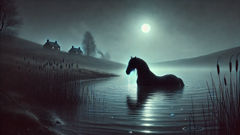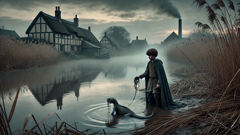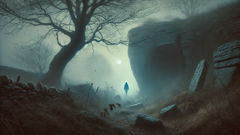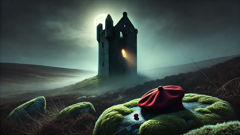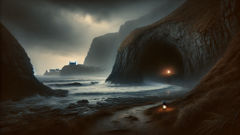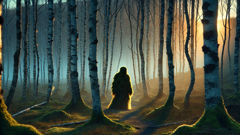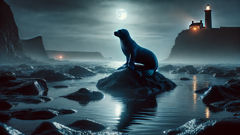Introduction
There are places in Scotland where water keeps its own calendar, where rivers remember winters and lochs hold the slow history of stones. Around these still eyes of water the world seems to listen: reeds whisper, swans tilt their heads, and the clouds move differently, as though the sky itself hesitates to press down. In villages threaded by a single road and a single stream, mothers teach children to respect the edge of the water as if it were a boundary between two countries—one known and solid, the other dark and patient. From the mouths of fishermen to the low murmuring at peat fires, the kelpie is spoken of in the same breath as drowning, as cold hands that do not release, as the soft noise that might be laughter or might be the sound of a horse drawing close. The kelpie, people say, is not simply beast or spirit but a shape that waters take when grief or hunger sits heavy in the world. It can come as a black horse with dripping mane, sleek as oil, or as a man who has stood too long on a shore. Sometimes it is no more than a ripple, a suggestion of hooves beneath a moon-silvered surface. This story follows paths between those suggestions: it moves down a river that remembers a thousand feet, across a loch that presses like a still book, and into the lives of the small people whose lives—like many lives near water—are braided with risk, song, and superstition. In remembering, in retelling, the kelpie becomes more than danger; it becomes a mirror for the choices men and women make where land stops and water begins. The tale is as much about the living who live in the shadow of the loch as it is about the creature itself, for the two cannot be separated. When the fog closes and voices are pulled thin across the dark, those who listen carefully might still hear a faint, watery neigh: a warning, a lament, or an invitation. If you sit by a loch at night, keep your feet away from the pale slick of stones. Look at the water, and listen for what it remembers.
The River That Spoke
The careful river winds away from the hills like a thought that will not quite finish. It runs for miles through peat and pasture, past stone bridges with moss eaten into their crevices, past a crofter's plot where rhubarb stands like dark tongues and linen flapping on a line snaps in a rhythm close to prayer. In winter there are nights when the river breathes fog, and dawns when you could mistake the quiet for something holy. Old men who have mended nets and hauled kelp for years say the river is a storyteller; listen closely and you will hear the cadence of other people's hearts in it.

It was along such a river that the first close of this tale takes root. The village of Innerly—or what had been called Innerly before the road bypassed it and the young left—sat where the river made a slow elbow. Houses of whitewashed stone leaned toward the water as though to eavesdrop. The inn, a thick-smelling room with peat smoke hanging low, had a sign hammered with a horse's head. Farmers and fishers met there to trade news and gossip, to count sheep, to grumble about weather. Children skittered along the riverbank with bare knees in summer, daring one another to step on the slick stones and to see what the water would tell them. They were taught the old words—the names of plants, the hour for sheep, the cadence for mending nets—and the quietest of these teachings was the crouching, urgent lesson about the edge.
The kelpie, parents would say, loves the laughter of the young because it makes their throats easy to pull. It loves the bold and the curious because they will come nearer to look. So they put rope around the smallest, tied bright rags on sticks, and told stories about horses that swear by salt. For the older folk there were other stories: of lost brides, of men who took horses from the water with bridles of iron and rode them too far, of women who married strangers from the river and found themselves waking with their hair full of silt and stones in the teeth. The kelpie in the river took many names and wore them like coats depending on who saw it and what they had lost.
On a summer when the heather was pale and the river ran thin and fast, a stranger came to the village. He rode a cart with a linen cover and a smell of iron and something like the sea. His name was Callum, though he did not say much and kept his face turned from the sun as if avoiding scales. He was a man with hands that had been used to ropes and to carving wood; he had eyes the color of a shallow rock pool and a way of stepping that made people notice him and then forget why they had. He stopped at the inn and drank hot tea and asked about work and about the river. He did not say he was searching for anything, but people who have spent their lives beside water know how to read a look. When he walked the bank at dusk, the dogs grew still, and the birds would not roost.
There was one in the village who watched him more keenly than the rest: Morag, a woman who had tended the graveyard and kept the old healings and charms. She had lost a brother to water and wore a silver chain with a small wooden cross beneath her shirt. She had a face folded by winter and a manner like an old tree—still, patient, and stern. Morag walked to the river with a reed basket and a lantern one evening and found Callum by the elbow where the water was clearest. He was looking at his hands as though they had grown new lines.
'You should keep away at night,' Morag told him without preface. 'The water is hungry.'
Callum did not start. 'Does your river speak to you too?' he asked, his voice a low thing.
She saw then that he did not ask as a stranger but as one used to listening. He had a gentle way of touching the water with the back of his hand and then drawing it near, as if coaxing out a memory. People speculated that he was a gypsy or a hawker, a man who had come from further north. He slept a night or two at the inn and took up work mending a gate beside the croft. He traded stories with the older lads who would pour him a dram and ask about foreign towns. But the river kept its own counsel. There were evenings when a shadow passed over the cart as it faced the moon and when the dogs woke with an agony of barking for no clear reason.
Not long after Callum arrived, a boy called Ewan, twelve summers and taller than his years, went missing. He had been daring at the water like other boys, flicking pebble shrapnel across the current, laughing as the splash scattered light. One moment he was on the bank; the next he was not. His brother found only his cap clinging on a reed, sopping and sucking with river. The village acted with the slow, desperate precision of those who know how to fetch a man from water: ropes, lanterns, prayers, a search that went on into morning. But there was no Ewan to be pulled. The river gave up nothing.
Grief sharpened superstition. Men made a raft and went out to feel the loch with poles; women set charms beneath the lintels. They said the kelpie had taken him, or that some old wrong had been returned like coin. Callum went with those searching and did not speak much; he placed his palm to the water and said a name the river might know. Morag watched him and thought of the ways a man could be both friend and stranger. Around the fire that night, with rain talking on the roof, some whispered that Callum's eyes were like a water horse's—that smooth shine that never sleeps.
The idea roots itself quickly in small places where wood and peat and myth are part of the same breath. Soon others recalled nights when horses had come to the edge, water tumbling from their manes like a long black rain. 'You could hear a hoof-sound beneath the surface,' an old fisherman said. 'Not on the stones, but under them.' They spoke in low voices of bridles that did not rust and of saddles that were heavier than a man should bear. And among these stories, a new thread took shape: the thought that some things are lured not by mischance but by a temptation that looks like a gift.
As the search for Ewan grew thin, as mornings blurred into each other and the river kept its face, that temptation appeared. It came in a small, cunning way: a mare appeared at the riverbank, shivering and wet, with a foal at her side. Calves and lambs and geese often drifted close, lost or frightened, and the village was not hostile to an animal in need. They left grain and warmed blankets for the mare, thinking the water must have shaken the animal scrubbed clean and exhausted. Callum stood near and watched as the mare nosed at the hands of the men who offered help. He bent and ran a palm along her neck as if reading the knot of muscles and the smell that lived in the animal. The mare had eyes that held a tempered intelligence; she did not flee. That same night, a child said he saw a shadow move under the surface not like a fish but something long and horse-flanked, and all the dogs in the village yelped.
Morag, who had known grief long enough to keep it warmed in her pocket like a second hand, watched less with disbelief and more with the small, exact tools of ritual. She used hair from a door-threshold braid and iron hammered at midday; she hung herbs on the lintel where the mare had been tethered. The village, hospitable and practical, tolerated gestures that cost little and might ease fear. Yet the air seemed loaded—thin, like glass under strain. Every movement toward the river felt like a movement toward a lit match.
When another youth vanished—this time a young woman called Aileen who had gone down to collect water and never come back—the blackness widened. She was found only later, on a morning when the loch spat up a bundle of seaweed and something that looked like a shoe. The village began to murmur that calling the kelpie a mere superstition was no longer sufficient. They took to leaving doors unlocked and lights burning in windows, as though illumination could discourage hunger. Superstition hardened into policy: children were kept closer to hearths; men took turns walking the bank at night; prayers were shared between breaths.
Callum, who had been quiet and watchful, began to walk the edge of the loch with his cart. He spoke softly when asked whether he had seen anything and sometimes offered a word of consolation that felt like a small payment for some other debt. He tied his cart to a post and hummed under his breath like a man making a boat. People speculated that the living can become like the things they have grieved: slow and secretive, with eyes turned toward water.
On a late autumn night when the wind had teeth and the reeds slapped like curtains, Morag found Callum at the river again. He held a lantern and a rope. 'You're not from here,' she said, folding her arms against the damp.
'No,' he admitted, 'but I've followed water a long time.'
'Then you know that we keep names here. We call them out when we bury someone, and sometimes that keeps the river from remembering them wrongly.'
He listened, and then he told her that his own sister had been taken when he was a boy, dragged under a black horse at the loch near where he'd been raised. He had left to learn the road and had returned only to hear the story told a thousand different ways. What he had learned was not the same as what others had learned. To him the kelpie was not only predator; it was also a being shaped by how people feared, fed, and named it. 'If you do not give a thing a name wide enough to hold it,' he said, 'it will make a name for itself.'
They spoke until the fire in Morag's lantern went like a thought. When they parted, she gave him a small iron pin, cold as the river's first wrinkle. 'Keep to the iron,' she said, 'and to the old names. They have teeth.'
Soon after, Callum did something that made the village uneasy. He waded into the river with rope and bridle and with a patience only someone with a long hunger for answers could have. He did not shout or fight. He tied a small bell to the bridle and went under the surface like a man who had been long in water. When men pulled him out, he had a new look in his eyes: softer, as if the river had given him a different understanding and a different sorrow. He spoke of a great horse that had grazed in a place beneath the stones and named each person in the river in a voice that sounded like tide. Some thought he had saved the village from the kelpie; others thought he had only been given the manner of its hunger. He never stopped looking at the water, and the dogs stopped barking at him.
The village recovered in the small, stubborn ways people do: they rebuilt nets, they stitched new clothes, and they started to laugh at the hearth again in bursts. Yet the river kept its stories. On still evenings a light would move beneath the surface, a ripple that suggested a neck. Children would stop playing when their mothers called and the shadow at the water's lip would seem a little closer. People learned that there are ways to live with things unknown, and that rituals—songs sung low, a ring of iron at a stable door, the keeping of names—are not merely superstition but a manner of argument with the deep. They maintained their boundary, and where boundaries are kept, life, however precarious, continues.
If there is a moral to this part of the tale, it is that water remembers and people remember, and that sometimes those two memories do not agree. You cannot simply prove a thing that lives under a loch by counting the fish. The kelpie exists in the behavior of the river and in the language of the people who live beside it. It exists where gap and danger meet, where the bold heart of youth presses forward, and where the patient hand of the elder pulls back. Most of all, the kelpie exists in the space where grief has not been named properly—when a loss lacks ritual and is left to become a hunger. In the end, the river keeps both the name and the silence, and the villagers keep both the stories and the iron pins that might, sometimes, be enough.
(End of first long section.)
The Loathsome Gift
A loch is a closed book with a wet spine; it keeps its own words and hides its margins. Where the river empties, the loch takes time—slow, merciless time. There are places around its rim where stones sit like old teeth and where the wind seems to chant a hollow syllable. The villagers called it the Blackmere, a deep basin where no one fished and where the water, even in sun, looked like a pool of night. Old maps put nothing there but a blank; weddings named it with a shiver. People who had been born beneath its shadow knew how to move with the loch's temperament: to cross quickly, to avoid the low-slung rocks smoothed by centuries, to never, ever let a child wander alone.
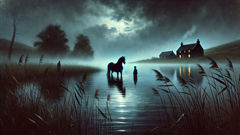
The kelpie of Blackmere was older than anyone's clear memory. It was said to wear the smell of weeds and the taste of dead fish. It could stand on the surface as if the loch had given it a float of skin and bone, and it could also come in a man's shape with a voice that made sense of your loneliness. There were tales of brides who took lovers from the loch and whose hair turned to silt. There were tales of fishermen whose boats moved like they were being pushed from beneath. Such things had become part of the grammar of life near Blackmere; their truth existed in the daily habits they enforced. Doors were kept fast when fog came down and hedgerows were thornier for miles, either by design or by memory.
One autumn, when the heather had turned and the sky had a hardness to it, a woman named Elspeth arrived at the village with a child at her breast and sorrow wrapped like a shawl around her shoulders. She had come from the north, from a place where the sea had taken a husband, and she had eyes that carried both a hunger and a carefulness. Elspeth settled in the cottage nearest the loch and took work washing at the inn and patching clothes. She told few stories of where she had come from and fewer yet of what she had seen. But people noticed the way she watched the water. In the evenings she would walk to the loch's rim and stand long enough that the dogs stopped barking and the reeds stopped rustling in reflexive warning. She would speak to the surface as one might speak to a stubborn child, and sometimes the water seemed to answer with a slow, uninterested ripple.
Her son, Angus, grew under the loch's shadows. He was of that age when daring begins to taste like triumph and when a child's bravery does not yet know caution. He would play by the stones, skimming pebbles and learning the river's tongue by throwing rocks and listening for their returns. Elspeth taught him to hold a tether when he reached the water, a cord looped at his small waist so a watchful hand might pull him back. Neighbors handed him coins and nicknames and warnings. In the evenings, when the sky was low and the loch looked like poured lead, Elspeth would walk with him and hum an old song her mother had taught her: it was not a charm to drive away the kelpie so much as a constant naming of the child to the world.
In a cruel twist of ordinary life, it was not the warning nor the tether that saved Angus but the manner of small kindness that misreads hunger as need. One day a black mare came to the loch’s edge. She had the sheen of something born of water, mane starched with droplets that fell like a scatter of small coins. The mare nudged Angus and let him stroke her flanks. She allowed him, and the other children, to climb her back and pretend they were kings of a frail world. Elspeth watched with a throat full of something like prayer. She did not trust the mare; she read the creature's eye and it held the long patience of a thing that had been long fed by secret hands.
When she caught Callum at the water then—he had not truly left the village, though he was quieter now and walked slower—he told her things in a low voice. He said he had learned to read the river, to feel the pressure where a creature might take, and that the kelpie's gift often looked like mercy at first: a tired horse, a spare meal, rescue. 'It gives to steal what it cannot get by other means,' he said. 'It shapes hunger into a tender thing so you will take it willingly.'
Elspeth understood that better than most. She had once watched a man she loved drown because he had walked into assistance with a stranger who smiled and offered bread. She had learned the slow arithmetic of trust: divide grief by caution, and you still have remainder. Yet the small kindness of the mare was visible to the others as simple compassion. The innkeeper offered oats, someone else left a blanket. They talked about how kind the animal had been, how close it had allowed people to come. To be kind to such a thing felt like defiance against the loch—a like-to-like answer to dark.
On a night rounded by fog, with wind pushing reeds into a low susurration, Angus and two other boys climbed upon the mare's back and rode along the loch's rim, laughing, convinced of their command of things. Aileen's younger sister, fragile still with a wound the village could never name rightly, watched and narrowed her eyes like a motherless pink. The men who were watching—because by then the village rotated its watchers in a tired, fatal choreography—hesitated as the boys ventured too close to the water's slick edge. Then, quickly and with no time for second thoughts, the mare walked a hair's width into the loch. It paused as if taking measure. The boys slid in the shallow glow and then the loch took them in a way that looked first like a deep breath and then like a closing hand.
Angus was pulled down before hands could reach him. The other boys were dragged by the current and vomited up later, gasping and pale. Angus was not found. Elspeth's scream was a new sound in the village, a sound that made grown men weep openly at the inn. She went to the water's edge and called the child's name until her voice gave like a rope breaking.
When the loch granted a small, cruel mercy—an old boot, a shirt sleeve with the child's name embroidered—people went mad in their sadness. They did what they had done before: they blamed the kelpie, they blamed the water, they blamed the way of the world. But Morag, who had taught the art of remembering, took the grief and turned it into a ritual. She did not scream; instead she collected the child's hair, a strip of cloth, and a small wooden cross and placed them in a cairn near the edge. She spoke the old words of naming. People came to lay stones and to push iron pins into the turf. They hung a bridle at the inn's door and nailed horseshoes to thresholds. They sang the child's name until it sat in the air like a grain.
Callum did not leave. Some said he had been the cause; others said he had merely been a part of the narrative by which the loch told itself. He went down to the water one dawn with a rope and a lantern and a small wooden box. In front of a half-moon and the watchful eyes of those who had stayed up all night, he fed the water a small offering: a spoonful of salt, a braid of his own hair, and the bell he had once tied about a mare's neck. He muttered under his breath in a language at once old and very personal. Then he let the box sink with a slow hand into the loch as children at play might drop a stone into an argument. People watched and felt something shift. Whether the loch ate that night or simply turned its face, no one could say.
Yet the real work, Morag told them, was not in the offerings but in the way they made their living near the loch: in the care of children, the naming of the dead, and the recognition that not every kindness is welcome. 'The kelpie will give you what looks like what you need,' she said. 'And sometimes what you need is the courage to refuse.'
In the months that followed, the villagers developed a new vocabulary for their days. They taught children to carry stones in their pockets when they walked near water. They tied bright scarves to rickety fences. Weddings were celebrated with an extra verse; births were named immediately so that the river would hear the child's voice and not swallow it like a secret. People learned that danger near water is not always the stroke of a beast but can be the slow misrecognition of hunger for help. The kelpie remained, as kelpies do, a presence at the margin: sometimes seen, sometimes only suspected when nets came back empty or when the mist curled in a way that looked like a mane.
Elspeth never recovered the child she had loved. Her life bent toward the loch after that, and sometimes she would sit at the edge with a spoon and a bowl and hum to the water. She never married again. Callum, who had once searched endless waters for a sister, stayed longer still and eventually left one morning with the rope coiled over his shoulder and the look of a man who had decided to answer a summons. Morag remained, keeping names and iron and small rituals alive, and the villagers kept their lights and their iron pins. They learned to look at kindness with a cautious eye and to remember that some gifts come with teeth. The kelpie persisted, as such things do, not as a simple bogey to frighten children but as a complex knot of hunger, loss, and place. It taught them what they had not wanted to know: that living beside deep, patient water requires a living that is both brave and careful.
(End of second long section.)
Conclusion
Stories like the kelpie endure because they bend toward what we are afraid to say aloud: that the border between safety and danger is often as thin as a stone's edge. The kelpie is not only a creature of water and teeth but a way to speak the danger of desire untrustworthy kindness and the sorrow that blossoms when grief is unnamed. In villages where lochs are mirrors and rivers keep counsel, the kelpie reminds people to name and to tether, to hang iron at doorways and to teach songs that speak a child's name across the smoke. It reminds communities that ritual is not empty superstition but a shared technology for surviving the unpredictable: naming the dead, keeping watch, and learning when to refuse the thing that looks like salvation. These are practical arts wrapped in myth, and they travel down generations not because they are pretty but because they are useful. In the modern world, the kelpie persists in a different guise—in the metaphors we use to warn against easy salvation, in our stories of online seduction and promises that glitter like oil, and in how we teach our children to measure kindness with caution. But there is also tenderness here: the kelpie's tale is a requiem for what communities have lost and a map for how they might keep what remains. It teaches that grief, named and ritualized, is less likely to become a hungry thing that takes others in turn. So when you next find yourself by a still stretch of water—whether loch, lake, or even a quiet river—stand with a sense of respect. Listen for the sigh that might be wind, or might be a deeper voice. Keep a small iron in your pocket if you must, but more importantly, keep a name in your mouth and a memory in your hands. That small attentiveness is often enough to make the difference between staying and being taken, between facing loss with ritual and succumbing to a silence that grows teeth. The kelpie, in the end, remains a symbol as old as water and as new as the fears we carry. It asks not only how we protect ourselves from the dark but how we honor what we have lost so that hunger does not breed among the living.

